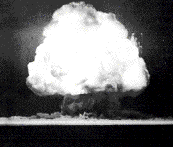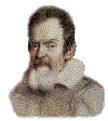


 |
 The one sentence definition: "Energy is the ability to do work" is next to useless unless one has a clear understanding of what "work" is. Energy is what we buy from the electrical company, energy is what we eat food for, energy can be extracted from gasoline in the tank and from waterfalls and the wind. Energy is what reaches us from the Sun and makes life on Earth possible. Energy is what gives us cancer if we get exposed to radiation. In all the variety of change around us, energy is converted from one form to another but is never lost. The appreciation of the idea comes when you realize the importance of any conservation principle. A conservation principle states that confusing as change may be, some quantities stay the same. All through human history people tried to make sense of things by looking for these invariant, conserved, quantities.
The one sentence definition: "Energy is the ability to do work" is next to useless unless one has a clear understanding of what "work" is. Energy is what we buy from the electrical company, energy is what we eat food for, energy can be extracted from gasoline in the tank and from waterfalls and the wind. Energy is what reaches us from the Sun and makes life on Earth possible. Energy is what gives us cancer if we get exposed to radiation. In all the variety of change around us, energy is converted from one form to another but is never lost. The appreciation of the idea comes when you realize the importance of any conservation principle. A conservation principle states that confusing as change may be, some quantities stay the same. All through human history people tried to make sense of things by looking for these invariant, conserved, quantities.
 Glimpses of the idea of energy predate Newton and his laws of mechanics. In 1638 the Italian scientist
Galileo published a book in which he noted that the speed of an object descending under gravity depends only on the height from which it is released and not on the path it takes. This is the germ of the idea of potential energy.
Glimpses of the idea of energy predate Newton and his laws of mechanics. In 1638 the Italian scientist
Galileo published a book in which he noted that the speed of an object descending under gravity depends only on the height from which it is released and not on the path it takes. This is the germ of the idea of potential energy.
 If you know the height from which an object is released, you can predict the speed it will attain. Or conversely, if you know the speed, you can predict the height it can attain. There are many different paths but something doesn't change. The sum total of potential and kinetic energies. Of course, friction can spoil the result. But then you get heat. And if you account for heat, the total energy still stays the same.
If you know the height from which an object is released, you can predict the speed it will attain. Or conversely, if you know the speed, you can predict the height it can attain. There are many different paths but something doesn't change. The sum total of potential and kinetic energies. Of course, friction can spoil the result. But then you get heat. And if you account for heat, the total energy still stays the same.
 In a paper in 1686 the German scientist
Leibniz (he also invented calculus independently of Newton) argued that the true measure of the effect of force is "living force" as exhibited in motion and not "dead force" as exhibited in statics. Buildings and bridges stay up by "dead force" whereas moving object possess "living force". The "living force" of Leibniz was the product of mass and velocity squared, (almost) what we now call kinetic energy. By the way, Leibniz wrote his paper to argue against the claim by another scientist that the product of mass and velocity was the universally conserved quantity. They were both right in some sense. In the weeks that follow we will have to sort this out.
In a paper in 1686 the German scientist
Leibniz (he also invented calculus independently of Newton) argued that the true measure of the effect of force is "living force" as exhibited in motion and not "dead force" as exhibited in statics. Buildings and bridges stay up by "dead force" whereas moving object possess "living force". The "living force" of Leibniz was the product of mass and velocity squared, (almost) what we now call kinetic energy. By the way, Leibniz wrote his paper to argue against the claim by another scientist that the product of mass and velocity was the universally conserved quantity. They were both right in some sense. In the weeks that follow we will have to sort this out.
 During the nineteenth century the term "physics" stopped being a synonym for general science . Physics meant the study of mechanics, electricity, and optics employing mathematical and experimental methodology. The unifying concept was energy.
The nineteenth century saw a rapid development of engineering and technology based on mathematics and physics. The invention of the steam engine led people to ponder the relation between motion and heat. Experiments with electricity and electric motors led people to ponder the relation between motion and electricity. The ideas of energy helped to destroy the notion that heat and electricity are strange forms of matter that has no mass and occupies no space. Such materials were called imponderables. In the 1840's Benjamin Thompson, a weird American scientist-engineer who became a German nobleman Count Rumford after he sided with the British in the War of Independence, proposed that heat and temperature are related to motion.
During the nineteenth century the term "physics" stopped being a synonym for general science . Physics meant the study of mechanics, electricity, and optics employing mathematical and experimental methodology. The unifying concept was energy.
The nineteenth century saw a rapid development of engineering and technology based on mathematics and physics. The invention of the steam engine led people to ponder the relation between motion and heat. Experiments with electricity and electric motors led people to ponder the relation between motion and electricity. The ideas of energy helped to destroy the notion that heat and electricity are strange forms of matter that has no mass and occupies no space. Such materials were called imponderables. In the 1840's Benjamin Thompson, a weird American scientist-engineer who became a German nobleman Count Rumford after he sided with the British in the War of Independence, proposed that heat and temperature are related to motion.

Subsequently
James Prescott Joules measured the mechanical equivalent of heat via an electrical. In 1847 he suggested that the motion of particles of matter is related to temperature. Ultimately these ideas have rise to atomic physics and modern chemistry. Again the unifying idea was energy. Heat energy was now added to mechanical forms of energy. The notion of work, first as the product of force and distance and then more formally as the integral of force with respect to distance was introduced at about the same time.
 In the early years of the twentieth century physicists gave up the idea that energy must be "property" of matter and accepted the notion that energy packets exist in their own right. Light is "pure" energy which is emitted by atoms can travel thorough space and can be reabsorbed by atoms. The ultimate demonstration of these ideas was the first nuclear explosion. And yet, as far as we know, energy in all its forms is conserved. It is constantly being transformed but it is never lost or created.
In the early years of the twentieth century physicists gave up the idea that energy must be "property" of matter and accepted the notion that energy packets exist in their own right. Light is "pure" energy which is emitted by atoms can travel thorough space and can be reabsorbed by atoms. The ultimate demonstration of these ideas was the first nuclear explosion. And yet, as far as we know, energy in all its forms is conserved. It is constantly being transformed but it is never lost or created.
 1. Who originated the idea of a horsepower?
1. Who originated the idea of a horsepower?
 2. What is the relation of the horsepower to a watt?
2. What is the relation of the horsepower to a watt?
 3. How is a BTU related to the joule?
3. How is a BTU related to the joule?